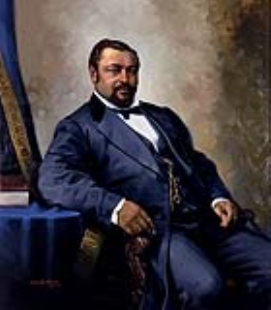
Of the 1,885 men and women who have served in the U.S. Senate since the founding of the republic, only five have been black. Remarkably, the first two were elected from Mississippi during the Reconstruction era that followed the Civil War. Hiram Revels served for a few weeks in 1870 and then returned to relative obscurity. Blanche K. Bruce, who held his seat from 1875 to 1881, amassed a small fortune and founded what Lawrence Otis Graham calls “America’s first true black dynasty.”
A few years after the Civil War started, Bruce ran away to Lawrence, Kansas and tried unsuccessfully to sign up with the Union Army. He moved back to Missouri in 1864, near the end of the Civil War. Living as a free man and inspired by his own passion for learning, Bruce started a school for black children. According to some accounts, in 1866 Bruce attended Oberlin College in Ohio and stayed on for two years, although Oberlin has failed to produce any records to support this theory. In 1868 he relocated to Mississippi and became a cotton farmer. Over time, he would accumulate 640 acres of land for his plantation.
Bruce made his foray into politics in 1870, when the Mississippi Senate elected him its sergeant-at-arms.
In 1874, the Mississippi state legislature elected Bruce to be its representative in the U.S. Senate, making him the second African-American to hold the position. He served from 1875-1881, and thus Bruce became the first African-American citizen to work a full term in the United States Senate.
During his term, he attempted to desegregate the U.S. Army and in 1878 became chairman of the Select Committee to Investigate the Freedman’s Savings and Trust Company. Concurrently, from 1877 to 1879, he was chairman of the Mississippi River’s Select Committee.
Bruce acted as presiding officer at the Republican National Convention in 1880 and 1888. Both times he received vice presidential nominations.
His wife, whom he married in 1878, came from the North’s tiny black upper class. After his Senate term expired, Bruce remained in Washington, D.C., where he held lucrative patronage posts, acquired a large townhouse and summer home, and presided over black high society.
The story of the Bruce family is both powerful and sad. In 1936, Bruce’s grandson ended up in jail and his legal fees caused the family to become bankrupt. Interestingly, many of their relatives, including the younger Clara and her actor husband, avoided racism by passing for white. Today, it is reported that most descendants of Sen. Bruce live as white persons.
Read all about it in “The Senator and the Socialite: The True Story of America’s First Black Dynasty” by Lawrence Otis Graham



No Comments